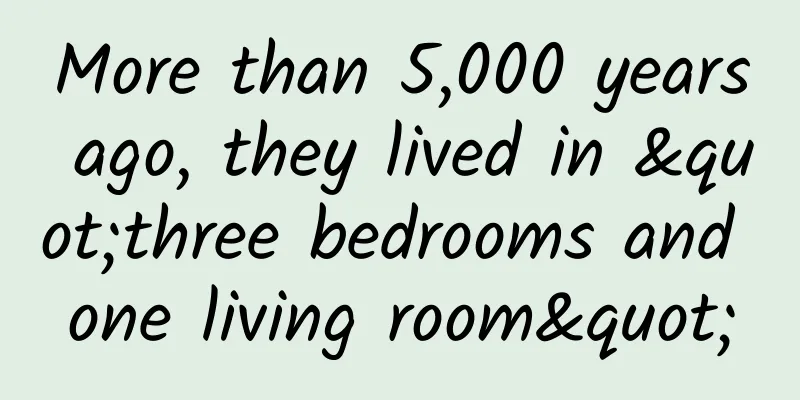More than 5,000 years ago, they lived in "three bedrooms and one living room"

|
On the banks of the great river, there are relics of our ancestors. Recently, the reporter visited the Dahe Village Ruins Museum and looked back at the civilization footprints of the ancestors of Dahe Village firing pottery, living and working in peace and contentment, and looking up at the stars a thousand years later, sensing the profound and brilliant imprint of civilization. Small mouth pointed bottom bottle "It's incredible that Chinese ancestors thousands of years ago had already built the prototype of modern houses, with fire pits and suites." In the Dahe Village Ruins Museum, the reporter couldn't help but sigh as he looked at the "three-bedroom and one-living room" house foundation from more than 5,000 years ago. The Yangshao culture house foundation F1-F4 unearthed at the Dahe Village Ruins still retains a complete floor plan and more than one-meter-high walls. It is the best-preserved prehistoric residential foundation discovered in China so far. "We can see the fire platform, fire-blocking wall, threshold and other devices in front of us. The foundation of this house is made of wood, and the walls are built by wrapping the wood with grass and mud. The two sides are smoothed with fine mud, and then covered with thatch after burning with a big fire. The house is warm in winter and cool in summer, and it is moisture-proof and anti-humid." The tour guide introduced, "This is of great significance for studying the history of ancient Chinese architecture, exploring the organizational structure of the society at that time, and the development of marriage and family." Yangshao culture house foundation. Sun patterns, moon patterns, halo patterns, comet patterns... "What did our ancestors want to express by creating these symmetrical, evenly ordered patterns?" It is understood that a large number of painted pottery unearthed from the Dahe Village site are colorful and rich in patterns, making them unique in the Yangshao culture. Its white painted pottery, red painted pottery, colorful pattern types, superb and skillful painting techniques, and a wide variety of artifact types mark that the prehistoric painted pottery culture has reached a peak. The unique patterns on the pottery represent the ancestors' observation of celestial phenomena. "The most amazing thing is that these pottery are the products of thousands of years ago, and the patterns on them are symmetrically distributed. At that time, when there were no precise measuring instruments, our ancestors had already made such exquisite patterns." It is understood that these astronomical images, which are closely related to the production and life of the ancestors, are likely related to agricultural production. In social practice, the ancestors observed and recognized the movement and changes of the sun, moon and stars, which are most closely related to human survival, and depicted them on pottery with vivid patterns, which have become the most abundant astronomical data discovered in China so far. They are about 2,000 years earlier than the astronomical records in the oracle bones of the Shang Dynasty, and have very important scientific value for studying the origin and development of ancient astronomy and calendar. Some of the exhibits in the Dahe Village Ruins Museum. "Is this the tool our ancestors used to steam steamed buns? It looks similar to today's steamers, but is made of different materials... This bottle is actually used to fetch water, I thought it was a wine vessel!" After learning the true functions of the pottery griddle and the small-mouthed pointed-bottom bottle, the reporter marveled at the advanced wisdom of our ancestors thousands of years ago. In addition, the ancestors of Dahe Village learned to make silk fabrics, invented bone needles, and made pottery rings, stone rings and other ornaments. They used slash-and-burn farming, gathering, fishing and hunting when outside, and weaving and spinning, making pottery and raising livestock when inside. Productivity continued to increase, living materials became increasingly abundant, and the social structure gradually evolved, transitioning from a matriarchal society to a patriarchal society. Some exhibits in the Dahe Village Ruins Museum In Zhengzhou, an ancient and fertile land, the Dahe Village Ruins Museum is like a window through time, shining with more than 5,000 years of historical glory, displaying the splendid imprint of early Chinese civilization, and engraving the glory of Chinese culture. |
<<: When optics “meets” AI, will it become the “killer application” of 5G and 6G?
Recommend
Maidian Research Institute: China Hotel Industry Development Report in April 2023
Market dynamics summary 1. Monthly overview: Mark...
The efficacy and function of Manshanbai
Many people know that Manshanbai has unique thera...
The efficacy and function of Perilla seeds
Perilla seeds are the dried and mature fruits of ...
What Chinese medicine is good for replenishing qi and blood?
Nowadays, as many women get older, they find that...
The efficacy and function of Sargassum spatholobi[picture]
The Chinese herbal medicine Sargentodoxae [pictur...
Popular Science Illustrations | What “wisdom content” does the National Library of Editions have?
...
AiKop | It is said that if you understand these, you will understand the early history of human navigation
Since ancient times, the mysterious ocean has att...
Natural fibers: used to weave cloth in ancient times and now used to make cars
As people's material life becomes more abunda...
What are the effects of Astragalus polysaccharide
Does everyone know what Astragalus polysaccharide...
The deeper the sleep, the better the quality of sleep? How important is it to have a good night's sleep?
In October 2020, survey data from the China Sleep...
Can Panax notoginseng and Gastrodia elata be eaten together?
Panax notoginseng and Gastrodia elata are both me...
my country's new coronavirus special medicine may produce another "dark horse" that can prevent mutant strains!
0.6 grams of antibody per injection, one injectio...
Is the pangolin the real-life version of "Wolverine"?
Source: China National Geographic Exploration Pla...
The difference between Acorus calamus and Acorus calamus
Acorus calamus is a commonly used clinical medici...
The efficacy and function of water shield
Water shield is a very common Chinese medicinal m...






![The efficacy and function of Perilla frutescens[Picture]](/upload/images/67ca18fca9da7.webp)


